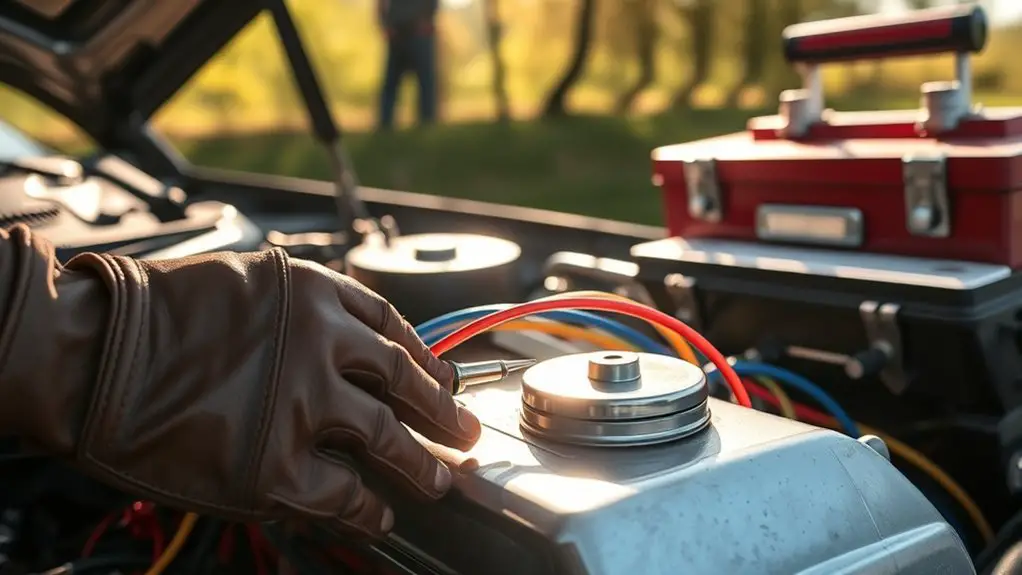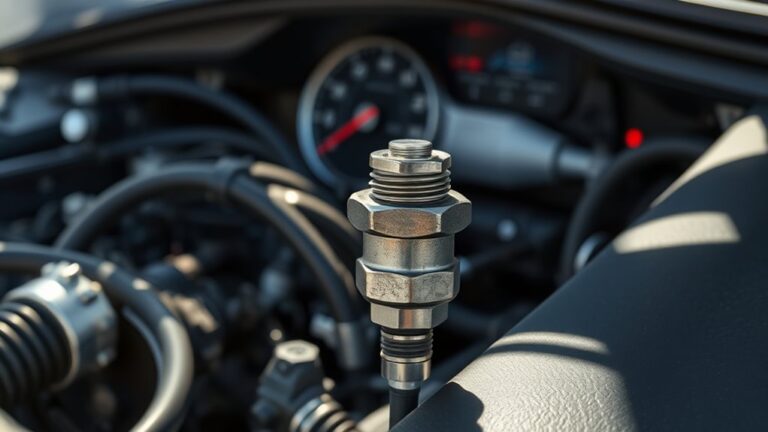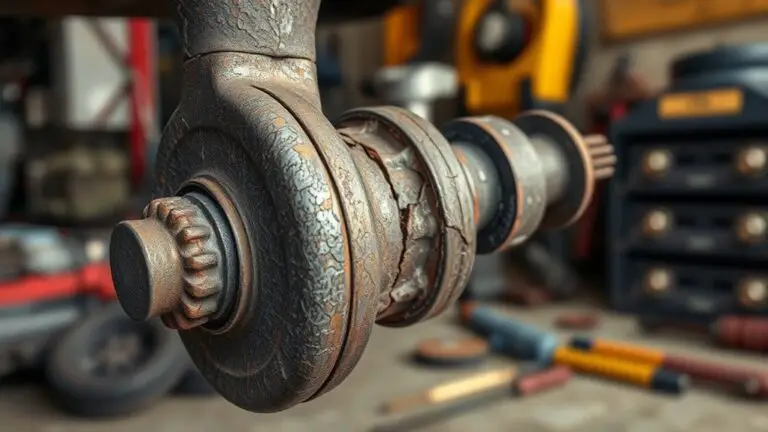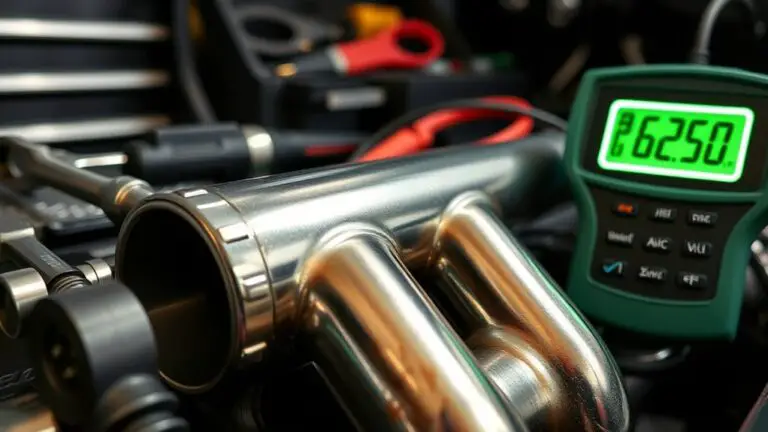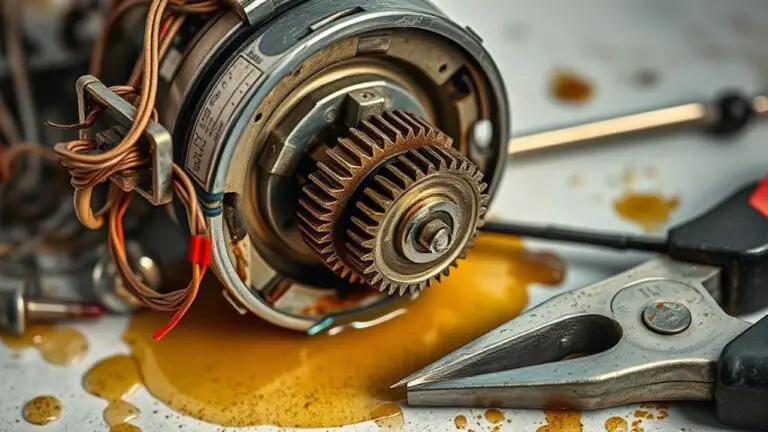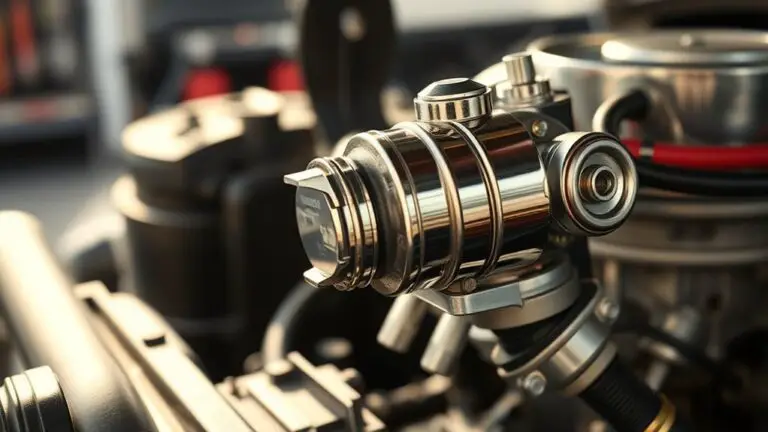Quick Checks for Engine Hesitation Before You Visit a Mechanic
If you’re experiencing engine hesitation, start by checking the fuel level and quality; contaminated fuel can cause issues. Inspect the air filter for dirt and the spark plugs for wear. Look for vacuum leaks around hoses and the intake. Test the battery and alternator to guarantee proper voltage. Evaluate fuel injectors for performance and use an OBD-II scanner to review engine codes. Finally, check the transmission fluid level. There’s more to explore on these checks.
Check the Fuel Level and Quality
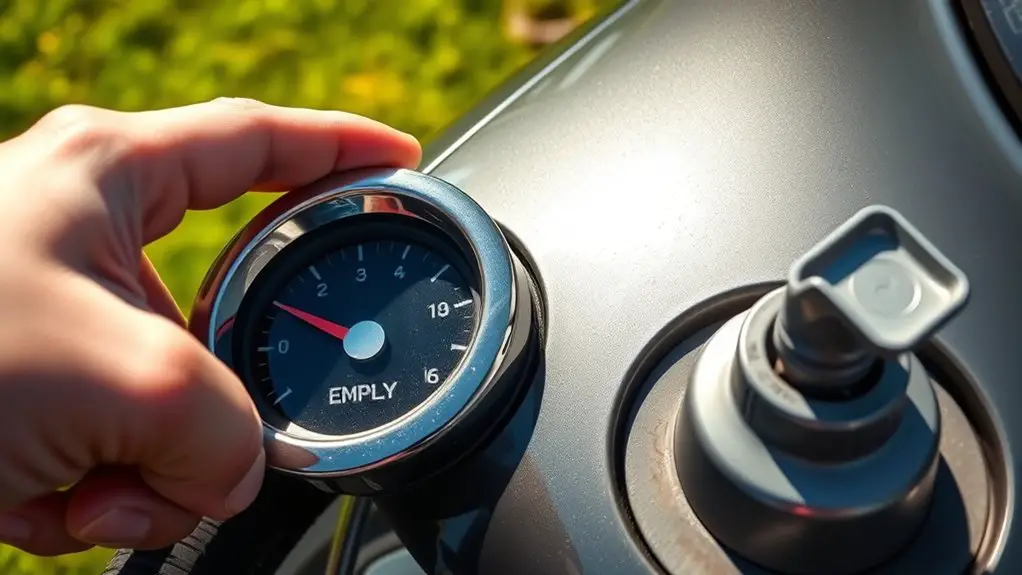
Have you ever considered how fuel quality might impact your engine’s performance? The type of fuel you use plays a vital role in how efficiently your engine operates. High-quality fuel can enhance combustion, providing better power and responsiveness. Conversely, poor-quality fuel can lead to engine hesitation and reduced horsepower.
It’s also important to think about fuel additives. These substances can improve fuel stability and prevent deposits from forming in your engine. Using the right fuel additives can enhance engine cleanliness and boost performance, especially if you frequently use lower-quality fuel.
Before heading out, check your fuel level to guarantee you have enough for peak operation. If you suspect your fuel might be subpar, consider draining it and refilling with a higher-quality option. By selecting the right fuel type and utilizing beneficial additives, you can maintain your engine’s freedom to perform at its best.
Inspect the Air Filter

The air filter is an important component in maintaining ideal engine performance. It guarantees that clean air enters the engine for optimal combustion. Regular air filter maintenance is significant; a clogged filter can lead to substantial airflow obstruction. When inspecting your air filter, look for dirt, debris, or any signs of damage. If the filter appears excessively dirty or discolored, it’s time to replace it.
A clean air filter allows for better airflow, improving fuel efficiency and engine responsiveness. Conversely, an obstructed filter can cause hesitation, especially during acceleration, as the engine struggles to draw in air. To maintain performance, check your air filter every few months or as recommended in your owner’s manual. By keeping a keen eye on this simple yet essential component, you can prevent potential issues and enjoy a smoother driving experience. Remember, a little proactive maintenance goes a long way in preserving your vehicle’s freedom on the road.
Examine the Spark Plugs
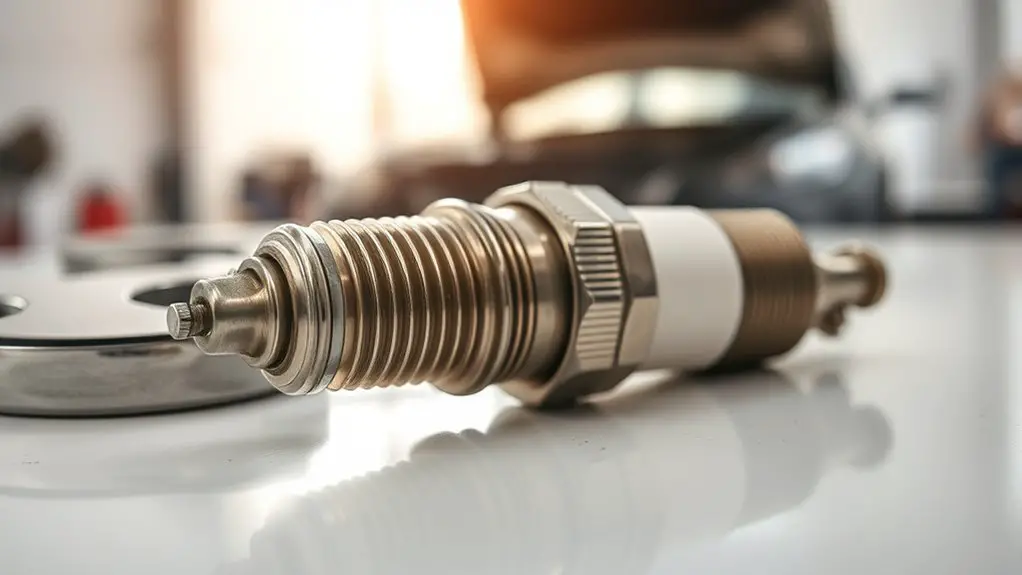
Inspecting the spark plugs is essential for ensuring your engine runs smoothly and efficiently. These small components play an important role in igniting the air-fuel mixture, and any issues can lead to hesitation or misfires. Start your spark plug inspection by removing the plugs and examining their condition. Look for signs of wear, such as cracks, corrosion, or excessive carbon buildup. If they appear worn or fouled, it’s time for spark plug replacement.
Ensure you’re using the correct specifications for your vehicle, as an improper type can lead to poor performance. Also, check the gap between the electrodes; if it’s out of spec, it can affect ignition. Regular spark plug inspections can save you from more significant issues down the road, so don’t overlook this essential check. By staying proactive, you can maintain your engine’s performance and enjoy the freedom of the road without hesitation.
Look for Vacuum Leaks
To address engine hesitation, start by identifying common vacuum leak areas such as intake manifolds and throttle bodies. Next, inspect hoses and fittings for signs of wear or damage, as these can often be the source of leaks. For a thorough check, use a soapy water test to reveal any escaping air bubbles that indicate leaks.
Identify Common Leak Areas
While diagnosing engine hesitation, identifying common leak areas is essential, especially when it comes to vacuum leaks. Start by checking around the intake manifold and throttle body, as these are common leak sources. Look for any cracks or signs of wear in the rubber gaskets or hoses. You should also check the vacuum lines connected to various components; these can deteriorate over time, leading to leaks. If you’re identifying fluid types, be on the lookout for any oily residue, which can indicate a different issue altogether. Using a smoke test can help you locate elusive leaks, making your job easier. Addressing these areas can considerably improve your engine’s performance and prevent further complications down the road.
Inspect Hoses and Fittings
Hoses and fittings play an essential role in maintaining a sealed vacuum system, and any deterioration can lead to engine hesitation. To guarantee your engine runs smoothly, carefully inspect these components for wear and tear. Look for signs of hose deterioration, such as cracks or bulges, which can disrupt airflow. Check the fitting connections for tightness—loose fittings can cause significant vacuum leaks.
- A small leak can lead to costly repairs down the line.
- You deserve an engine that responds swiftly to your commands.
- The freedom of the open road is compromised by hesitation.
Use Soapy Water Test
If you suspect vacuum leaks may be causing engine hesitation, the soapy water test is an effective method to identify the problem. Simply mix water with dish soap to create a soapy application, and then apply it to suspected areas, such as hoses and fittings. If there are leaks, you’ll notice bubbles forming, indicating where air is escaping.
| Area to Test | Signs of Leaks |
|---|---|
| Vacuum Hoses | Bubbles forming |
| Intake Manifold | Bubbles forming |
| Throttle Body | Bubbles forming |
| PCV Valve | Bubbles forming |
| EGR Valve | Bubbles forming |
Performing this simple bubble detection can save you time and money before heading to a mechanic.
Test the Battery and Alternator
To guarantee your engine runs smoothly, it’s crucial to test the battery and alternator, as they play important roles in the vehicle’s electrical system. A failing battery can lead to reduced battery lifespan and impact your engine’s performance, while a malfunctioning alternator can cause inadequate power supply.
Here are some quick checks you can perform:
- Check battery connections for corrosion or loose terminals.
- Test voltage output with a multimeter; it should be around 12.6 volts when the engine is off.
- Inspect the alternator belt for wear and proper tension.
Addressing these issues early can save you the frustration of unexpected breakdowns and guarantee your vehicle remains your trusted companion on the open road. Prioritizing battery and alternator health means you can enjoy the freedom of the drive without hesitation or worry.
Evaluate the Fuel Injectors
When evaluating the fuel injectors, it’s essential to check their cleanliness, as buildup can hinder performance. You should also inspect for any leaks that could disrupt fuel flow. Finally, testing injector performance will guarantee they’re delivering the correct amount of fuel to the engine.
Check Fuel Injector Cleaning
Though fuel injectors are often overlooked, their cleanliness is essential for peak engine performance. Neglecting fuel injector maintenance can lead to engine hesitation, reduced power, and increased emissions. To guarantee your engine runs smoothly, consider these effective injector cleaning methods:
- A clean engine means fewer headaches on the road.
- Improved fuel efficiency gives you more freedom to explore.
- A smoother ride enhances your driving experience.
Regularly check and clean your fuel injectors using professional services or DIY methods to keep them functioning at their best. By prioritizing injector cleanliness, you’ll not only maintain superior engine performance but also enjoy the freedom and reliability your vehicle provides. Don’t let dirty injectors hold you back from your adventures!
Inspect for Leaks
Inspecting for leaks in your fuel injectors is essential, as even a small leak can lead to significant engine performance issues. Conducting thorough fluid inspection will help you identify potential problems early. Start by checking for any visible signs of fuel leakage around the injectors or fuel rail. Use a cloth to wipe the area and see if any fresh fuel appears after running the engine.
Here’s a quick reference table for leak detection:
| Leak Location | Symptoms | Immediate Action |
|---|---|---|
| Injector Seals | Rough idling, stalling | Inspect seals, replace |
| Fuel Lines | Strong fuel smell | Tighten connections |
| Fuel Rail | Puddles under the car | Replace rail |
| Engine Bay | Fuel stains on components | Clean and inspect |
Addressing leaks promptly can restore your vehicle’s freedom on the road.
Test Injector Performance
To guarantee ideal engine performance, evaluating the fuel injectors is essential, as their efficiency directly impacts fuel delivery and combustion. Start with performance testing to check if your injectors are delivering the correct amount of fuel. Use a multimeter to test the resistance and verify they’re functioning within specifications. If you notice irregularities, injector cleaning can restore their performance and improve combustion efficiency.
- Feel the thrill of a responsive engine.
- Enjoy the freedom of smooth acceleration.
- Experience the joy of reliable performance.
Review Engine Codes With an OBD-II Scanner
How can you quickly diagnose engine hesitation issues? One effective method is to use an OBD-II scanner. This handy tool reads trouble codes stored in your vehicle’s computer, providing insights into potential problems. The OBD II benefits include quick access to error codes, which can greatly simplify scanner troubleshooting.
Here’s a brief overview of what to look for:
| Code Type | Description | Action Recommended |
|---|---|---|
| P0300-P0399 | Misfire codes | Inspect ignition system |
| P0420-P0429 | Catalyst efficiency codes | Check exhaust system |
| P0171-P0175 | Fuel system codes | Examine fuel injectors |
Check the Transmission Fluid Level
While you’re diagnosing engine hesitation, checking the transmission fluid level is crucial, as low or dirty fluid can lead to shifting issues that might mimic engine performance problems. If you suspect transmission issues, inspect the fluid to verify it’s at the recommended level and free of contamination.
Here’s how to check:
- Look for a bright red color: This indicates clean fluid, while a dark or brown hue suggests contamination.
- Check the smell: A burnt odor signifies overheating, which could lead to costly repairs.
- Assess the consistency: Grit or particles in the fluid can indicate internal damage.
Regularly monitoring your transmission fluid can save you from unexpected breakdowns and costly repairs. Don’t let fluid contamination compromise your freedom on the road. By staying proactive, you maintain your vehicle’s performance and guarantee a smoother driving experience.
Frequently Asked Questions
How Do I Know if My Fuel Is Contaminated?
To know if your fuel’s contaminated, watch for contamination signs like rough engine idling, stalling, or decreased performance. You might notice unusual smells or a darker color in the fuel. If your vehicle struggles to start or accelerates poorly, it could indicate poor fuel quality. Checking for water or particulates in your fuel can also help. If you suspect contamination, it’s wise to replace the fuel and clean the system for peak performance.
What Symptoms Indicate a Faulty Air Filter?
If your air filter’s faulty, you might notice reduced engine performance, such as sluggish acceleration or rough idling. You could also experience decreased fuel efficiency and unusual engine sounds. A clogged air filter restricts airflow, leading to a rich fuel mixture that affects combustion. Additionally, you might see warning lights on your dashboard or experience increased emissions. Regularly checking your air filter can help maintain peak engine performance and prolong your vehicle’s lifespan.
Can Worn Spark Plugs Cause Engine Hesitation?
Yes, worn spark plugs can definitely cause engine hesitation. They play an essential role in spark plug maintenance and are critical for peak engine performance. When spark plugs wear down, they fail to ignite the air-fuel mixture properly, leading to misfires and uneven acceleration. This can result in noticeable hesitation while driving. Regular inspection and replacement of spark plugs can help maintain engine efficiency and guarantee a smoother driving experience.
How Do I Detect a Vacuum Leak?
To detect a vacuum leak, start by listening for any hissing or whistling sounds around the engine. You can also spray a soapy water solution at suspected areas; bubbles indicate a leak. Watch for vacuum leak symptoms like rough idling, poor acceleration, or a check engine light. Using a smoke machine is another effective method for detecting leaks, as it visually reveals escaping smoke from any cracks or loose connections in the intake system.
What Should I Do if My Battery Is Weak?
If your battery’s weak, start by checking the connections for corrosion and ensuring they’re tight. You might need to perform some battery maintenance, like cleaning terminals. If it won’t start, consider jump starting it with another vehicle. Make sure to follow proper jump-starting procedures to avoid damage. If the problem persists, it could be time to replace the battery. Regular checks can help you maintain battery health and prevent future issues.

